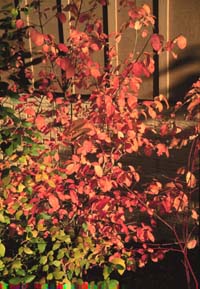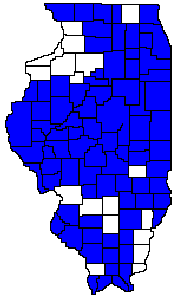 |
| Black
Haw (Viburnum prunifolium)
Distribution
Map to Right |

The black haw is also called smooth blackhaw. It occurs as a small, bushy tree or large shrub, growing between 10 and 25 feet tall, with a short trunk that has a diameter of about 6 inches. It has an irregular crown with stiff, spreading branches.
Black haw grows on a range of moist to dry, open sites in rocky upland forests. It is also common along fence rows and thickets. It tolerates dry conditions very well, and can grow in either sun or shade. It is present in most counties in Illinois, and ranges from Connecticut to Michigan, south to Texas and east to northern Florida.
Interesting
Facts
Viburnum
species are widespread and common in the eastern deciduous forest. Most
are shrubs and all have fleshy fruits containing a single seed. They are
difficult to characterize as a group because there are few all-inclusive
characteristics among different species. Smooth blackhaw has alligator-hide
patterned bark, just as the flowering dogwood does. However, its bark is
corkier than that of flowering dogwood.
Identifying Features
BarkUses
Black haw bark is reddish-brown to dark brown or black and has a distinctive "blocky" appearance.
Twigs
The twigs are smooth, slender, gray or brown, and have orange-colored lenticels (pores, either circular, elliptical, or stripe shaped, on the bark that allow the exchange of gases).
Buds
Buds are 1/2 inch in length, gray or reddish-gray and sometimes covered with purplish hairs.
Leaves
The leaves are opposite, oval with short, pointed tips, and are rounded or tapering to the base. The leaf margins are toothed. They are 2-3 inches long, shiny and dark green on the upper surface and paler and smooth or slightly hairy on the lower surface. The leaves turn bright red in the autumn. Leafstalks are less than an inch long.
Flowers
The flowers occur in upright, flat-topped clusters of small, white flowers. Individual flowers are 1/4 inch or less in diameter, whereas the flower cluster is up to 4 inches wide. The flowers appear in April and May.
Fruits
Fruits are shiny, bluish-black, ovoid, and occur on bright red stalks. They occur in September to October. Song and game birds, as well as a variety of small mammals and deer eat them.
Black haw is used as an ornamental because it possesses year-round ornamental qualities similar to those of flowering dogwood. The flowers and berries are attractive and the tree is small and nicely shaped. It also tolerates dry conditions and will grow in sun or shade. Black haw wood is coarse grained, hard, and heavy, but it is also brittle.